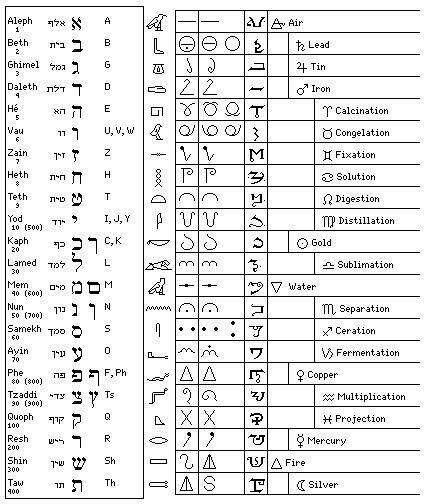
This page is not intended to promote belief in the supernatural, and includes content of a satirical nature. |
When four people sit down to play a game of Bridge, the dealer selects which suit is to be the trump suit. If you find the foregoing statement startling, no doubt you have become confused because people playing a later game derived from Bridge, the game of Contract Bridge, often just call that game "Bridge" for short, it having so thoroughly eclipsed that of the original (which is also known as Russian Whist). In Contract Bridge, the process is more involved; the player who promises to win the most tricks, should his selection of the trump suit be accepted, gets to make the choice.
Even Bridge is an elaboration of an earlier game, Whist, in which the cards are cut to determine which suit is the trump suit.
If you heard the announcement that a special deck of cards existed, designed to play an earlier and simpler form of Whist in which the cards belonging to a special fifth suit were always the trumps, would you not be interested to learn more about this unusual deck of cards? If it were added that this deck of cards is currently available in many bookstores, and the symbolism of the cards of the fifth suit, greater in number than those of the other suits, conveys the teachings of an early Protestant denomination, the Waldensians, surely the surprise would increase?(1)
Well, perhaps not. By now, most readers will realize that I am referring to the deck of cards used by upscale cartomancers, the Tarot cards. But what is this about the Waldensians? Well, for example, the card known as "The High Priestess" was originally "The Papess", and recalled a rumor which claimed that a woman in disguise not only became a priest, but was elevated to the Papacy, being found out only when she gave birth during a Papal procession. I first encountered this theory in Roger Tilley's A History of Playing Cards, but similar theories, sometimes involving the Cathars or the Albigensians instead, had been advanced by others. (The paragraph which preceded this one, incidentally, is a parody of the introductory paragraph of the relevant section of the volume in a series of books which introduced the notion of the Tarot deck as having serious mystical significance to the European public.)
Before Champollion and the Rosetta Stone spoiled everyone's fun, it was claimed by occultists that the Tarot cards embodied the lost wisdom of the ancient Egyptians. As the great Egyptian civilization was about to crumble, the sage priests of Egypt, in a stunning display of freedom from ethnocentricity, left behind, as their legacy to the future, a pictorial key to the Kabbalah. (In this connection, an anecdote I once read about harpsichordist and composer Wanda Landowska comes to mind. Yes, it's [one of] the one[s] involving Bach.)
Etteilla was even quite specific about it: in the year 1828 after Creation, 171 years after the flood, 3953 years prior what was presumably the year 1783, and hence in the year 2181 B.C., seventeen illustrious Egyptian mages came together to design the Tarot, twelve of whom were descendants of Hermes Trismestigus himself. (In addition to the Tarot, one wonders if they left behind the minutes of the meeting at which it was designed. Of course, were Etteilla in posession of such a document, it would justify his extensive rearrangement of the order of the Major Arcana...) On the other hand, if Paul Christian (Paul Pitois) is to be believed, the twenty-two keys of the Major Arcana had long been in use in Egypt for the training of initiates.
Incidentally, if 2181 B.C. is the year 1828 after Creation, then Creation would have taken place in the year 4009 B.C., which is close to 4004 B.C., the figure due to Archbishop Ussher, but differing from the figure of 3761 B.C. which is the basis for the era of the Jewish calendar.
(It might astonish modern readers that someone engaged in fortune-telling by cards, an occult spiritistic practice clearly forbidden by Holy Scripture, would be a Creationist, a stance usually associated with Bible-believing Christians. However, this was 1783 - and Alliette only lived until 1791. James Hutton's book, Theory of the Earth, was only published in 1788, and the theory of Uniformitarianism which he presented therein only became widely recognized after John Playfair presented it in more readable prose in 1802, according to Wikipedia. Let alone Charles Darwin's On the Origin of Species, which was first published in 1859. So Alliette really did not have an alternate view of the world's origins available to him.)
And indeed, some of the sources for these speculations on the Tarot use the alphabet of Cagliostro (which did pre-date him, having appeared in a book by Vigenére) to argue that the Jews simply stole their alphabet from the Egyptians; since this notion suffers the embarassing lack of a single papyrus in the alphabet in question, it's hard to attribute such a notion to anything but anti-Semitism; although possibly not that of the authors themselves, but instead a pandering to the surrounding climate.
Actually, though, to be kind, there is another possibility; some of the letters of the Hebrew alphabet are hard to distinguish from one another, and thus to use an alternate form of the characters in which each character is clearly distinct might have seemed appropriate.
Incidentally, though, I have recently come across the writings of Christine Payne-Towler, from which I have learned that the account of the Major Arcana by Paul Christian is likely based on a document from the Fratres Lucis, and that Etteilla's ordering of the trumps reflects the Pymander.
Of course, it could be that the Egyptian traditions and the Kabbalah simply derived from a common source, in Atlantis, or even Lemuria. Lemuria: that lost continent, located in the Indian Ocean, where it provided an explanation for why lemurs were found in both Madagascar and (as fossils) in Indonesia. Doubtless my readers are all familiar with the Philadelphia Experiment, in which the secret theories of Dr. Albert Einstein (and perhaps the lost notebooks of Nikola Tesla, and scraps of information gleaned from crashed flying saucers) were used in an attempt to develop a cloaking device for U. S. naval vessels. Under somewhat less secrecy, even presented to the public in major newspapers - but in a veiled form - Einstein also experimented with time travel, bringing to the present a primitive man from this ancient continent; from this research, we learned that Lemuria was originally divided into the rival kingdoms of Lem and Mu. These rival kingdoms were eventually united, forming a civilization so advanced that it eventually caused the entire continent to float up into the air and settle down in the Pacific ocean. (On a smaller scale, this technology allowed the Pyramids to be built.)
But a chunk of the continent proved a home to separatists who wanted to divide the ancient kingdom of Lem from Lemuria, and thus they floated a chunk of the continent to the Atlantic ocean, where it became known as Atlantis; this explains how Atlantis and Lemuria managed to exist while blatantly contradicting the facts of plate tectonics.(2)
However, this story, however comical it may seem, is not entirely false. In early times in America, many board games for children were designed with educational themes, particularly leaning towards the religious. Our game of Snakes and Ladders is said to be derived from a game in India that helped to expound the Hindu doctrine of reincarnation, and in Tibet, a somewhat more complicated game is played to illustrate the progress of souls according to Buddhist belief. And in ancient Egypt as well, the game of Senet was meant to illustrate the difficulties of earning a good place in the afterlife.
And this game survives, in an altered form, to the present day. We call it backgammon, with Ludus Duodecim Scriptorum as its intermediate ancestor.
Also, as the title of Papus' book Le Tarot des Bohémiens recalls, it was believed that the Tarot cards not only came to Europe from Egypt, but were brought there by the Romany, known as Gypsies precisely because of their reputed Egyptian origin. As we know now, their ancestors came from India; but then, playing cards also came to us from India as well, after having been invented in China. But the Tarot trumps were still a European invention.

Since the Tarot deck consists of four regular suits of cards, cups, coins, batons and swords, each with cards from Ace to 10 as well as Knave, Knight, Queen and King, as well as 21 trumps, and one additional card, the Fool, that can be played to a trick in any suit, but which always loses the trick, those claiming an ancient mystical meaning for those cards, quite naturally, speculated that the 21 trumps and the Fool correspond to the 22 letters of the Hebrew alphabet. An "Egyptian" alphabet, also called the Alphabet of the Magi, used by Count Cagliostro, and following the pattern of the Hebrew alphabet, was associated with the Tarot trumps in Paul Christian's History of Magic without even mentioning the Hebrew alphabet; this alphabet is presented in the fourth column following the Hebrew alphabet in the chart on the left. This was originally recorded as a Chaldaean alphabet by the Christian scholar Theseus Ambrosius, who is famed for providing the Western world with its first grammar of the Syriac language.
Here is the form in which he originally presented it, in his work Introductio in Chaldaicam Linguam, Syriacam, atque Armenicam, et Decem Alias Linguas from 1539.
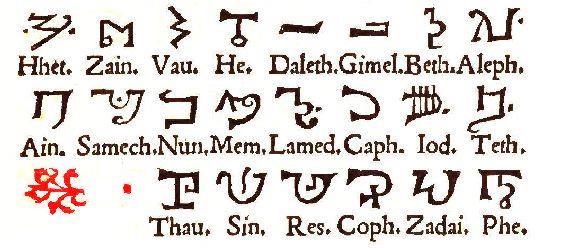
To reduce confusion, I've changed a decorative flourish, added to make the alphabet fit nicely into a rectangle, to red in color.
Note that the form of the letter Yod is significantly different in this form of the alphabet. By the time we get to Vigenère in Traicté des Chiffres, ou Secretes Manieres d'Escrire from 1586, however, the alphabet is changed to its later form:
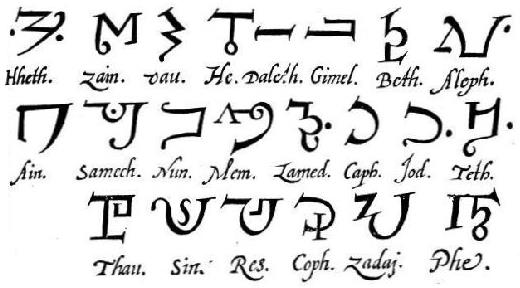
It is preceded by actual Egyptian hieroglyphs which vaguely correspond to the letters of the Hebrew alphabet. The letter L is represented by a biliteral hieroglyph whose value is "rw"; it was originally thought to be the Egyptian letter L because it was used to spell Cleopatra's name. Many people are aware that Her Majesty Cleopatra the Seventh was one of the Ptolemies, belonging to a Greek dynasty that ruled Egypt in consequence of the expeditions of Alexander the Great; but perhaps few realized that she was so alien to Egypt that the Egyptians could not even pronounce her name properly. Note also that, since these hieroglyphics are presented in association with the Hebrew alphabet, they are presented in the orientation they would have when used for writing from right to left, which is the more common writing direction for ancient Egyptian.
The letters of the Hebrew alphabet are associated in the diagram with letters from our alphabet in a traditional way which reflects the descent from the original Phoenician alphabet of our alphabet. But while Aleph is the ancestor of the letter A, and Ayin is the ancester of the letter O, these characters represented consonants and not vowel sounds in ancient Hebrew. Information on the actual use of the Hebrew alphabet in writing is given here.
The Tarot trumps have been ordered in three ways in decks designed for fortune-telling or occult study. In the first column below, I give the ordering due to Eliphas Lévi, which is the same as the conventional order of the trumps, except that the Fool is placed between the 20th and 21st trumps. In the second, I give the ordering used in the deck drawn by Pamela Colman Smith for Arthur Edward Waite, in which the Fool is the first of the trumps, and Justice and Strength are exchanged.
The third column shows the revised ordering of the Tarot trumps, or the Major Arcana, that Waite came up with after he left the Golden Dawn to form an organization of his own, the Fellowship of the Rosy Cross (not to be confused with the Rosicruicians).
Waite still used the traditional form of the Tree of Life, and the Major Arcana, in this order, were placed in correspondence with the Hebrew alphabet in its conventional order. This new ordering was used as the basis for another set of Tarot cards which he commissioned from the artist John Trinick, but these are very much obscure, unlike the set that he had Pamela Colman Smith draw back when he used the Golden Dawn ordering of the Trumps.
In the fourth column is given the ordering of the trumps used in the deck by Etteila. While several cards in Etteila's version of the Tarot do not resemble any card in the conventional Tarot closely, before Etteila's own deck was published, he had written a book on fortune-telling with the Tarot cards in which he described how the cards in a conventional deck should be renumbered; the entries depending on this source, and not obvious from the appearance of the cards in his deck are put in parentheses. A version of Etteila's deck first designed in Italy, the Tarocco Egizio, and more recently reprinted in Mexico as the Tarot Egipcio, assigned the letters of the Hebrew alphabet to the cards of that arrangement in alphabetical order, and the correspondence of those letters to the Major Arcana in the other decks is also held to be that of the cards in their given order with the Hebrew alphabet in its order.
One might also mention an exception to placing the Hebrew alphabet in order alongside the cards: in Liber al vel Legis, Aleister Crowley, who otherwise used the ordering of the Rider-Waite deck shown in the second column, maintained the ordering of the cards, but noted that Tzaddi was not the Star, and followed through by interchanging it with Hé, the letter associated with the Emperor. It is not recorded if that means that The Emperor is the heart of the Major Arcana.(3)
The fifth column gives the ordering of the Trumps in the Revived Tarot, due to a webmaster with the username Psyche, and inspired by the work of Carlo Suárez.
In this system, the Major Arcana represent not twenty-two, but twenty-seven symbols, with the fact that the final forms of five Hebrew letters are placed at the end of the Hebrew alphabet when it is used to represent numbers being taken as important. In most cases, however, the same trump corresponds to the regular and final form of the five Hebrew letters with final forms, with the only exception being that The Hermit corresponds to regular Yod, while The Sun corresponds to final Yod.
Donald Tyson, co-author of a book about the Necronomicon of H. P. Lovecraft in popular culture, has also proposed a revised order for the Tarot Major Arcana, based on the astrological significance of the Hebrew letters (which is what prompted the exchange of Strength and Justice by the Golden Dawn as seen in the popular Waite deck).
Also, the Comte de Mellet - and perhaps Court de Gébelin himself as well - ordered the trumps in reverse, beginning with The World, and ending with The Magician followed by The Fool.
There is something one must give Aleister Crowley credit for, however. He is also the inventor of Pirate Bridge, which for a time was considered by many respected Bridge experts to possibly be the next major advance in the Whist family of games after Auction Bridge.
Papus Waite Waite Etteilla Psyche Donald Tyson
(Golden Dawn) (Fellowship of the
Rosy Cross)
The Magician The Fool The Emperor (The High Priest) The Fool The Fool Aleph Justice Athoïm
The High Priestess The Magician The Empress The Sun The World The High Priestess Beth The Star Beïnthin
The Empress The High Priestess The Wheel of Fortune The Moon The Wheel of Fortune The Magician Ghimel The Moon Gomor
The Emperor The Empress The Chariot The Star The Tower The Empress Daleth The Empress Dinaïn
The High Priest The Emperor Strength The World The Emperor The Emperor Hé The Hanged Man Eni
The Lovers The High Priest The Magician (The Empress) The High Priest The High Priest Vau The Lovers Ur
The Chariot The Lovers The Fool (The Emperor) The Lovers The Lovers Zain The Devil Zaïn
Justice The Chariot The High Priestess (The High Priestess) The Chariot Temperance Heth The Magician Heletha
The Hermit Strength The Judgement Justice Strength Strength Teth The Judgement Théla
The Wheel of Fortune The Hermit The Hermit Temperance The Hermit The Hermit Yod Death Ioïthi
Strength The Wheel of Fortune Death Strength The Sun The Wheel of Fortune Caph The High Priestess Caïtha
The Hanged Man Justice The Hierophant (The Hanged Man) Justice Justice Lamed The Hermit Luzain
Death The Hanged Man The Hanged Man The Lovers The Hanged Man The Hanged Man Mem Temperance Mataloth
Temperance Death The Sun The Devil Death Death Nun The Tower Naïn
The Devil Temperance The Devil The Magician Temperance The Chariot Samech The Wheel of Fortune Xirön
The Tower The Devil The Lovers The Judgement The Devil The Devil Ayin The Chariot Olélath
The Star The Tower Temperance Death The Empress The Tower Phe The Emperor Pilôn
The Moon The Star The Moon The Hermit The Star The Star Tzaddi The Fool Tsadi
The Sun The Moon Justice The Tower The Moon The Moon Quoph The World Quitolath
The Judgement The Sun The Star The Wheel of Fortune The Magician The Sun Resh The Sun Rasith
The Fool The Judgement The Tower The Chariot The Judgement The Judgement Shin Strength Sichen
The World The World The World The Fool The High Priestess The World Than The High Priest Thoth
The Sun final Yod
The Hanged Man final Mem
Death final Nun
The Empress final Phe
The Star final Tzaddi
It may also be noted that the Tarot cards of the Major Arcana depicted by Papus (Gerard Encausse) in his Le Tarot Divinatoire, following the order of Eliphas Lévi, bear on them, in addition to Hebrew letters, Sanskrit letters and Egyptian Hieroglyphs, symbols labelled "Archéomètre Saint-Yves". These are from a little-known book, Archéomètre, written by the Marquis Joseph-Alexandre Saint-Yves d'Alveydre, which contained charts giving mystical correspondences for the letters of several different alphabets. These symbols are shown in the diagram above in the first and second column following the Hebrew alphabet, between it and Cagliostro's Alphabet of the Magi. The first column shows how they appeared on the Divinatory Tarot of Papus, and the second column shows how they appeared in the actual Archéomètre; in fairness to Papus, some of the symbols appeared in multiple forms in that work, and some alternates are shown in that column.
Note that the interchange of the last two symbols is substantive: the correspondence given in Archéomètre is between the characters of this primitive alphabet and the Hebrew alphabet, not the Tarot trumps; thus, this is not due to a dispute over whether The World should be numbered 21 or 22, although the placement of The Fool by Papus could have been the reason for an error in associating these symbols with the Hebrew alphabet.
Also of interest is the fact that of the five unrecognizable cards in the Eteilla deck, the first four are also the cards which were temporarily replaced with the images of four Moors in Tarot decks produced in some parts of Europe.
In Etteilla's deck, the trumps from The High Priest to The Chariot had the numbers from 1 to 21, while The Fool had the number 78. The Minor Arcana were numbered in reverse order, from the King down to the Ace, with the King of Wands as 22, the King of Cups as 36, the King of Swords as 50, and the King of Coins as 64.
If the unusual ordering of the trumps of Eteilla were due to a re-ordering of the Hebrew letters into the separate categories of double, mother, and simple letters, could that unusual ordering conceal a more conventional ordering? One possibility thus suggested is shown in the seventh column above.
In the eighth column are the names of the letters of Cagliostro's Alphabet of the Magi.
The starting point for the sequences above is, of course, the order of the Trumps in the Tarocchi deck as it was in existence for the purpose of card-playing. But that, also, had variations:
The Fool The Fool The Fool
1. (The Magician) (The Magician) (The Magician)
2. (The High Priestess) (The High Priestess) (The High Priestess)
3. The Empress The Empress (The Empress)
4. The Emperor The Emperor (The Emperor)
5. The Pope The Pope (The Lovers)
6. The Lovers (The Lovers) Temperance
7. The Chariot The Chariot Strength
8. Justice Temperance Justice
9. The Hermit Justice The Wheel of Fortune
10. The Wheel of Fortune Strength The Chariot
11. Strength (The Wheel of Fortune) (The Hermit)
12. The Hanged Man (The Hermit) The Hanged Man
13. Death The Hanged Man Death
14. Temperance Death The Devil
15. The Devil The Devil (The Tower)
16. The Tower (The Tower)
17. The Star The Star The Star
18. The Moon The Moon The Moon
19. The Sun The Sun The Sun
20. The Last Judgment The World The World
21. The World (The Last Judgment)
the first column being the sequence we are most familiar with, from the Tarot de Marseilles and many others, and the second being that of the Tarot of Bologna. Of course, that the subject of the page is reasonably thought of by many as being baloney is another matter. The third column shows those portions of the forty-one trumps of the Minchiate deck which appear to correspond to the conventional Tarots. Between The Devil and The Star are Hell, followed by the three virtues Prudence, Faith, and Charity, the four elements Fire, Water, Earth, and Air, and then the signs of the Zodiac in an irregular order: Libra, Virgo, Scorpio, Aries, Capricorn, Sagittarius, Cancer, Pisces, Aquarius, Leo, Taurus, and Gemini. Following The World is one additional card, Fame.
The vexing question of the order of the Tarot trumps might be felt to be solved, or at least to have taken a giant step on its way towards a solution, if there were any authoritative source of the meanings of the 22 letters of the Hebrew alphabet. And there is one with, at least, the weight of tradition behind it: the Sepher Yetzirah, or the Book of Formation.
Aleph Air 11 Scintillating Intelligence curtain before disposition Beth Life (/Death) Wisdom 12 Intelligence of Transparency visions, apparitions Gimel Peace (/War) Health 13 Uniting Intelligence Essence of Glory, consummation of truth of individual things Daleth Wisdom (/Folly) Fertility 14 Illuminating Intelligence founder concealed ideas of holiness & stages of preparation He Sight Speech 15 Constituting Intelligence substance of creation in pure darkness Vau Hearing Mind 16 Triumphal or Eternal Intelligence pleasure of the Glory Zain Smell Movement 17 Disposing Intelligence provides faith to the righteous, foundation of excellence Heth Speech Sight 18 House of Influence increases influx of good things, draws forth arcana and hidden senses Teth Taste Hearing 19 Int. of All the Activities of the Spiritual Beings diffuses affluence and exalted sublime glory Yod Eros Work 20 Intelligence of Will means of preparation of each created being, existence of Primordial Wisdom becomes known Kaph Riches (/Poverty) Life 21 Intelligence of Conciliation receives divine influence from benediction Lamed Work Desire 22 Faithful Intelligence increases spiritual virtues Mem Water 23 Stable Intelligence has virtue of consistency among all numerations Nun Movement Smell 24 Imaginative Intelligence gives likeness to all similitudes similar to its harmonious elegancies Samech Anger Sleep 25 Int. of Probation or Tentative Int. temptation by which righteous are tested Ayin Mirth Anger 26 Renovating Intelligence changing things renewed by it Pe Grace (/Indignation) Power 27 Exciting Intelligence intellect and motion of every created being Tzaddi Imagination Taste 28 Natural Intelligence nature of every existent being consummated and perfected Quoph Sleep Mirth 29 Corporeal Intelligence forms every body beneath worlds and their increment Resh Fertility (/Solitude) Peace 30 Collecting Intelligence judgement of stars and signs deduced from it by astrologers Shin Fire 31 Perpetual Intelligence regulates the motions of the Sun and Moon Tau Power (/Servitude) Beauty 32 Administrative Intelligence directs and associates operations of the seven planets in their courses
In the first column are the letters. The second gives the meanings as listed in the body of the Sepher Yetzirah, in the order they are listed. But the meanings are not explicitly connected to the letters, a later source which gives an explicit connection, gives a different order, noted in the third column.
Then, at the end, the meanings assigned to the paths from 11 to 32, the first ten paths being the Sephiroth, which we shall see below, in the essay The Thirty-Two Paths of Wisdom by Joannes Stephanus Rittangelius in 1642 are noted.
With the Intelligence of Probation assigned to the letter Samech, being the twenty-fifth path, this would seem to decisively favor the traditional order, where The Devil is the fifteenth card, as opposed to the Rider-Waite order.
However, while Administrative Intelligence, associated with Tau, makes the association of that letter with The World at least plausible, there is not really that much else in the sequence which is that closely related to the Tarot cards. However, Perpetual Intelligence, associated with Shin, suggests that the mystery trump for that position, for which The Fool only fills in, might have a calendar as its symbol, since calendars are based on the cycles of the sun and the moon (and, while The Sun and The Moon are two individual Tarot trumps, none of the arcana seem to be associated with both the sun and the moon together).
In the sequence of trumps as given by Papus, Aleph, corresponding to the element of air, corresponds to The Magician (or The Juggler); Mem, corresponding to the element of water, corresponds to Death. If The Fool, standing in for Shin, which corresponds to the element of fire, is taken out of the sequence of trumps, would it really correspond to the element of earth, the classical element left over from the three assigned to the three Mothers in the Hebrew alphabet?
In that case, two possibilities suggest themselves for the 21st Arcana; Time, as a complement to Death, or an accomplished magician, as a complement to both The Fool on the one hand, and The Magician - generally believed to represent a neophyte - on the other. The latter, though, is already represented by The High Priestess; while the former ties in well to the previous suggestion of that trump being The Calendar; as well, Time being an abstraction, it might have been difficult to properly depict, making its card appropriate to leave out as an impediment to those unworthy of initiation into the Mysteries.
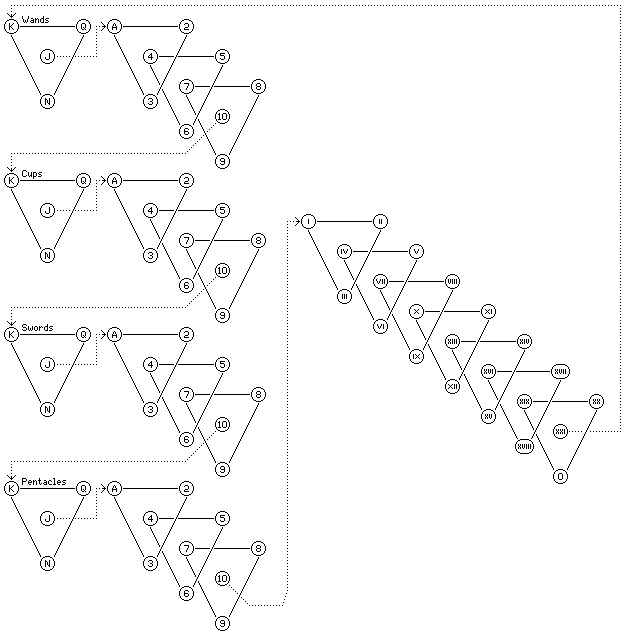
Above is a diagram illustrating the plan of the Tarot according to a scheme given in The Tarot of the Bohemians by Papus, and also used in The Tarot, a Contemporary Treatise on the Quintessence of Hermetic Occultism by Mouni Sadhu.
Each triangle represents a relationship between four cards patterned after the four letters of the Tetragrammaton, the Name of God.
Yod represents an active element, the first Hé a passive element upon which the active element acts, Vau represents the neuter result of the action, and the second Hé the overall system. Thus, one simple analogy to this is a father, a mother, a child, and the family. The overall system then functions as an active element on the next plane.
This pattern is repeated through the 22 cards of the Major Arcana; for each of the suits of the Minor Arcana, the King, Queen, Knight (represented by N in the diagram) and the Knave (represented by J in the diagram) represent one instance of the pattern, and the cards from Ace to 10 represent three repetitions of the pattern. The four suits of the Minor Arcana are ordered as they are because they also represent one instance of the pattern. Note that the last card in the Minor Arcana, the ten of coins, represents a transition to the Major Arcana, and the last card in the Major Arcana, The World, represents a transition to the Major Arcana.
Also, recall that The Fool, represented by 0, is simply a placeholder for the 21st position in the sequence - the actual card, the 79th card of the Tarot, being something one is to discover for oneself when one is ready, according to this system of understanding the Tarot.
The book The Tarot by Mouni Sadhu is based on the Encyclopedic Course of Occultism by Grigory Ottonovich Mebes. While that work is referred to as unavailable in Mouni Sadhu's book, in fact it was published in Russia in 1912 in two volumes. Naturally, due to first the Great War and then the Bolshevik Revolution, it may well not have been available until a copy turned up after the fall of the Soviet Union. There was even another edition published in 1937 in Shanghai.
Although his day job was as a mathematics professor, and his esoteric activities were known to but a few, he was eventually discovered and sent to a labor camp in which he perished.
Despite this, he wrote a sequel to his earlier work, which dealt with the Minor Arcana. Editions Pensamento, in Brazil, published a Portuguese translation of this book as well as the original Encyclopedia of Occultism, the latter under the title Os Arcanos Maiores do Tarô, and the former under the title Os Arcanos Menores do Tarô.
More recently, Alchemical Weddings has published, under the Shin Publications imprint, English translations of both works, under the titles Tarot Majors and Tarot Minors, making the latter available in English for the first time (much of the text of the former being embodied within Mouni Sadhu's book).
In this book, a correspondence between the pip cards of the Minor Arcana and the Sephiroth (discussed below) is given which seems to conflict with the plan of the Minor Arcana shown in the diagram above.
The two "red" suits - Coins (corresponding to Diamonds) and Cups (corresponding to Hearts) correspond to the ten Sephiroth in forwards order. Swords (corresponding to Spades) correspond to the ten Sephiroth in reverse order; Wands (corresponding to Clubs) correspond to the ten Sephiroth in both orders together.
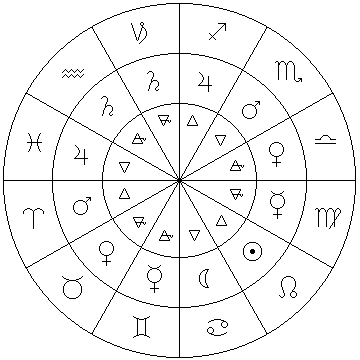
The traditional rulerships of astrological signs create a correspondence between the five planets and two luminaries known in antiquity, and the ancient four elements of air, earth, water and fire, and the twelve signs of the Zodiac. Note that while the twelve signs of the Zodiac correspond to the simple letters in the Hebrew alphabet in alphabetical order, the order of the planets is not regular.

The Kabbalists did not merely assign meaning to the individual letters of the Hebrew alphabet. One of the central concerns of Kabbalism was with the nature of God and His relationship to His Creation. The absolute perfection of God implied that He was utterly transcendent, and, thus, for Him to deal with a Creation that was so completely beneath Him seemed inconsistent.
Thus, a construct called the Tree of Life was derived from attempts to read between the lines of the Old Testament. It constituted an arrangement of ten Sephiroth, these being attributes or emanations of God. While God Himself, as the Ain-Soph, still remained completely untouched and untouchable above the diagram, it still was held to illustrate the link between the divine and the material.
The traditional version of the Tree of Life is illustrated on the left. The ten Sephiroth are:
1 Kether Crown 2 Chokmah Wisdom 3 Binah Understanding 4 Chesed Mercy 5 Geburah Severity 6 Tiphereth Beauty 7 Netsach Victory 8 Hod Glory 9 Yesod Foundation 10 Malkuth Kingdom
and 22 paths, corresponding to the letters of the Hebrew alphabet, are shown which link them together.
The letters are arranged on these paths in a manner based on alphabetical order, thus, each letter is accompanied by the number of its position in the Hebrew alphabet to make this clearer.
Of course, even if this intense approach to Scriptural exegesis is suspect in the eyes of more orthodox followers of either the Bible or the Old Testament, known as the Tanakh (short for Torah, Nevi'im, u-Ketuvim, The Law, the Prophets, and the Writings) to those who do not recognize it as having been updated with a supplement, the mystics who pursued Kabbalistic study cannot be held responsible for the occult dabblings of those who appropriated their tradition to apply it to the Tarot cards.
It may be also be of interest to note that, in Hebrew, Kabbalah is spelled Quoph Beth Lamed Hé, which letters have the respective numerical values of 100, 2, 30, and 5. These add to 137, and this is the integer which is approximated by the inverse of the fine-structure constant, which is the ratio between the speed of an electron orbiting the nucleus of a hydrogen atom in its lowest energy state (in a classical model) and the speed of light.
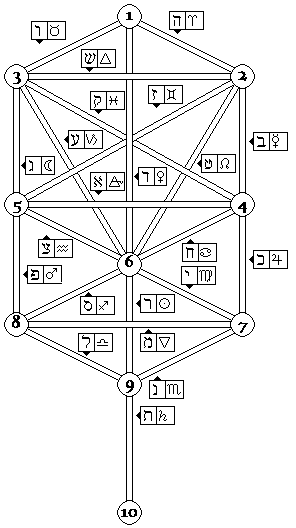
Later thinkers in the mystical tradition of the Kabbalah eventually proposed other arrangements of the Tree of Life. Isaac ben Solomon Luria developed the arrangement shown at the right. Here, the fact that three paths are horizontal, and seven paths are vertical, has been noted, and the three mother leters and the seven double letters have been placed into correspondence with those paths.
To make this clear, each Hebrew letter has been accompanied by the element, planet, or sign that was placed into correspondence with it, since those correspondences followed this division of the letters.
In addition to a different correspondence of the letters, note that two of the diagonal paths in the diagram are different.
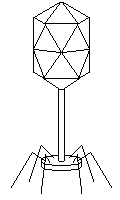
It may be noted that much later, molecular biologist Salvador Edward Luria, who, with Max Delbrück and Alfred D. Hershey won the 1969 Nobel Prize in Medicine for the discovery of how viruses caused infection and reproduced themselves, was known for his studies of one group of viruses in particular, bacteriophages, some of which looked like the drawing on the left.
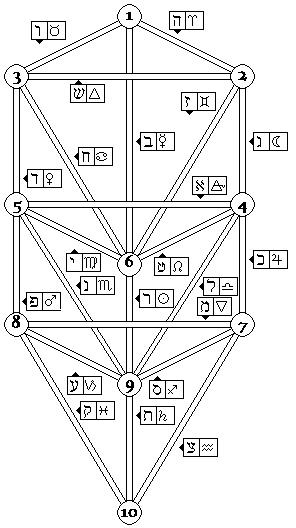
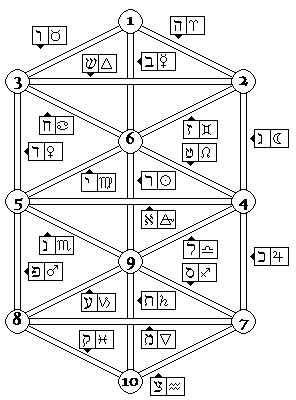
This arrangement, an even later one due to Rabbi Elijah ben Solomon Zalman, the Gaon of Vilna (Vilnius, Lithuania), is depicted here on the left in a form intended to facilitate direct comparisons. Normally, this arrangement is depicted, as on the right, with the circles representing the Sephiroth numbered 6, 9, and 10 moved up one position to highlight the inherent symmetry of the arrangement.
One discussion I recently came across refers to this arrangement as the "Gra" form, and claims it to have been the original form of the Tree of Life.
While it is not the earliest known form, a view held by many modern Qabalists is that this was the original pure form of the Tree of Life before the Fall of Man, with the current effective form being that of Luria.
In the Sepher Yetzirah, one chapter discusses the six permutations of the three distinct letters found in the Tetragrammaton, Yod, He, and Vau, and then the next one discusses the six permutations of the three "mothers" in the Hebrew alphabet, Aleph, Mem, and Shin. As we've seen above, the three letters of the Tetragrammaton are used in one scheme of analyzing the Tarot cards, and the three mother letters are significant in some versions of the Tree of Life.
Could these be linked together by finding an equivalence between the three "mothers" of the Hebrew alphabet, and the three letters represented in the Name of God?
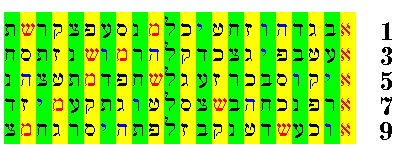
One obvious stratagem is foiled, because not only are these two sets of three letters spaced differently in the Hebrew alphabet, but the three "mother" letters are all in odd-numbered positions. This is significant because there are 22 letters in the Hebrew alphabet, or 2 times 11, just as in our own alphabet, there are 26 letters, or 2 times 13; in each case, two times a prime number. Thus, a new sequence of letters, in which each letter appears only once, can be generated with decimations of the alphabet by any odd factor modulo the length of the alphabet, except the one equal to half its length.
But multiplying by such a number leaves all the letters in odd positions still in odd positions, and all those in even positions still in even positions. Thus, no linear transformation modulo 26 will bring the three "mother" letters (shown in red in the diagram), all in odd positions (the ones with yellow backgrounds), into coincidence with the three letters of the Tetragrammaton (shown in blue in the diagram), one in an odd position, and two in even positions (the ones with green backgrounds).
On the other hand, if we set The Fool and the Hebrew alphabet aside, it may be significant, and no mere coincidence, that there are 21 visibly different rolls of two identical dice, and 56 visibly different rolls of three identical dice.
Certainly, this is highly encouraging to those who would connect the Tarot to Chess, Checkers, board games with dice such as Backgammon, Snakes and Ladders, and Pachisi and perhaps even Go (Wei Ch'i), Tablut, and Nine Men's Morris together in an interconnected web of shared symbolism.
And, for that matter, not only are there 56 visibly different rolls of three identical dice with six sides, there are also 56 visibly different rolls of five identical dice with four sides; thus, an ancient Greek system of fortunetelling with dice assigned the same set of meanings to the rolls of three dice with six sides and the rolls of five dice with four sides.
The doctoral dissertation Würfel- und Buchstabenorakel in Griechenland und Kleinasien by Franz Heinevetter is an important source for information about this system of divination.
Another amusing sidelight that might be mentioned here is that, for many years, while Tarot decks were unusual and thus hard to find in smaller communities, there was a Tarot deck of sorts that could be ordered by mail for the low price of $3.95. However, it only contained 56 cards.
I am, of course, referring to Zolar's Astrological Tarot Deck, which has only recently gone out of print. Here's part of an advertisement for this deck, showing several of the cards:
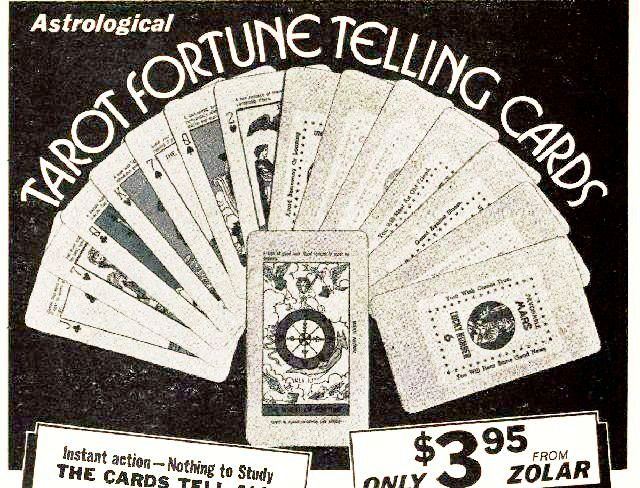
The 56 cards each bear on their faces an image of one of the 56 Minor Arcana cards from the Rider-Waite Tarot, as drawn by Pamela Colman Smith in 1909. The cards are only printed in three colors, however, black, red, and green. Except for the Knights of the four suits, these cards also bear conventional card indices from the conventional deck of playing cards.
On the back of the cards, with a green border, are:
Two cards, which in later decks are simply blank cards with a solid green color, but in the earliest decks had advertising for other products by Zolar;
The 22 Major Arcana, also from the Rider-Waite deck;
A 32-card deck of astrological fortune-telling cards. This deck was actually also sold on its own by Zolar as a separate product; in that form, the backs of the cards also were not identical, but instead contained further details on the interpretation of each individual card (as I learned from someone having a specimen of this particular rare and obscure deck on eBay).
A video on YouTube shows someone flipping through an early deck of this type, showing which cards are printed on the backs of which other cards. Another video, this one narrated in Spanish, examines a later specimen of this deck, one now printed by Parker Brothers. Many, but not all, the cards are shown front and back, and the arrangement is a different one. This arrangement seems to have been chosen with careful thought about the meanings of the cards on the two sides. A web page mentioning the front and back of just one card indicates that at least a third arrangement exists!
If one were looking for a legitimate link between the cards of the Major Arcana and cards in the original deck of playing cards, however, there is another possibility, the Petit Oracle des Dames. This is a 42-card deck, which associated playing cards with most of its cards, and which also recycled the Tarot card artwork from the Grand Etteilla.
1) 8D The World 15) 6S r) KS The Emperor 29) 10S 2) 9H The Sun 16) 10D The Hermit(b) r) The Lovers(a) 30) 5S 3) 7S The Moon 17) 5H The Lovers(b) 31) AH 4) 8H The Star 18) KD 32) 3D 5) 10C 19) 3C The High Priestess 33) AD r) 8C 6) 8S 20) QD 34) AC 7) 9D The Devil 21) 3S The Fool r) 2S 35) 4S 8) 4D r) Strength 22) r) The High Priest 36) 5C r) 7D 9) 4C The Hanged Man 23) AS 37) QS r) 6H 10) 4H Temperance r) The Empress 24) 2H r) 2D 38) KH r) KC 11) 2S Justice 25) 6S r) 5D 39) QC r) QH 12) r) The Wheel of Fortune 26) 10H 40) JH r) JC 13) 9S r) Death 27) 9C 41) 7C r) 7H 14) 3H r) The Hermit(a) 28) 6D 42) JS r) JD
The artwork noted as The Hermit(a) shows an old man walking with a staff; the artwork noted as The Hermit(b) shows a man holding a lantern. The artwork for The Lovers(a) is more reminiscent of that of traditional Tarots, while that for The Lovers(b) more closely corresponds to what is found on the Grand Etteilla.
Note that two of these cards have no playing card meaning, while twelve of them have a second playing card meaning when reversed. As 42 plus 10 is 52, that should mean the entire deck is accounted for. In some cases, it is uncertain which orientation should be considered reversed.
I have found, from an old book published in 1906, images of twelve of these cards, which I show below:
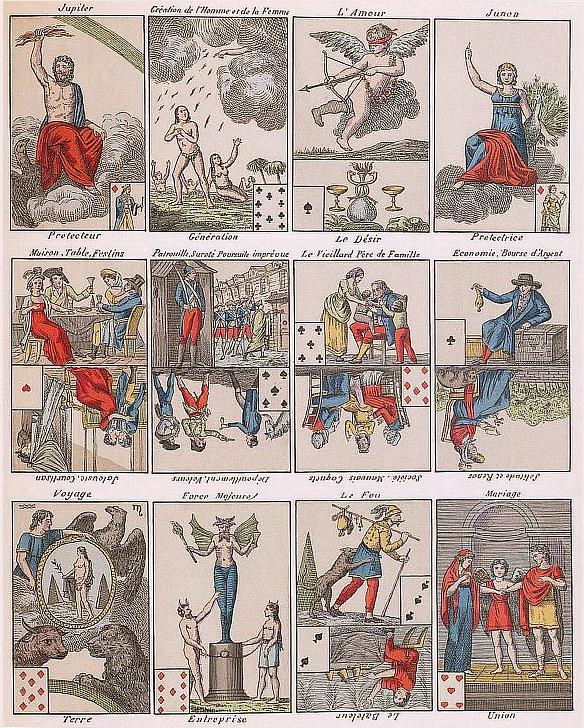
The cards shown here are, according to their numbers from the list above, the cards numbered:
18 5 23 20 31 30 36 34 1 7 21 17
Although my initial reaction to this particular fortune-telling deck, due to its recycling of the Etteilla artwork, was to dismiss it as completely insignificant and worthless... I just remembered that the number of cards in that deck has been indicated as of the utmost significance by a certain well-known authority.
Another form of divination that involves mathematical patterns is described in a page about Geomancy.
(1) In case the reader does not recognize this, it is a paraphrase of the following famous quotation:
"If it were to be announced that there survives today a work of the ancient Egyptians, one of their books that escaped the flames that devoured their superb libraries and which contains their purest doctrines on interesting subjects, surely everyone would be interested to know about such a valuable and extraordinary book. If it were added that this book was widely spread in a large part of Europe, that for several centuries it has been in the hands of almost everyone, surely the surprise would increase. Would the surprise not be even greater if you were assured that it was never suspected to be Egyptian, that we possessed it unknowingly, that no one had ever sought to decipher a page; that the fruit of exquisite wisdom is looked upon as an insignificant pile of extravagant cards? Would you not be inclined to believe your credulity was being toyed with?
"Yet this is entirely true: this Egyptian book, all that remains of their superb libraries, exists in our days: it is also so common, that no scholar had bothered to pay attention to it; no one before us had suspected its illustrious origin."
...and, of course, it is the deck of Tarot cards which is claimed to be this book.
From Le Monde Primitif by Antoine Court de Gébelin, in the eighth volume.
Or, in the original:
"Si l'on entendoit annoncer qu'il existe encore de nos jours un Ouvrage des anciens Egyptiens, un de leurs Livres échappé aux flammes qui dévorèrent leurs superbes Bibliotheques, & qui contient leur doctrine la plus pure sur des objets intéressans, chacun seroit, sans doute, empressé de connoître un Livre aussi précieux, aussi extraordinaire. Si on ajoûtoit que ce livre est très-tépandu dans une grande partie de l'Europe, que depuis nombre de siècles il y est entre les mains de tout le monde, la surprise iroit certainement en croissant: ne seroit-elle pas à son comble, se l'on assuroit qu'on n'a jamais soupçonné qu'il sût Egyptien, qu'on le possede comme ne le possédant pint, que personne n'a jamais chercé à en dechiffrer un feuille: que le fruit d'un sagesse exquise est regardé comme un amas de figures extravagantes qui ne signifient rien par elles mêmes? Ne croiront-on pas qu'on veut s'amuser, se jour de la crédulité de ses Auditeurs?
"Le sait est cependant très-vrai: ce Livre Egyptien, seul rest de leurs superbes Bibliotheques, existe de nos jours: il est même si commun, qu'aucun Savant n'a daigné s'en occuper; personne avant nous n'ayant jamais soupçonné son illustre origine."
(2) Of course, the name Einstein can be taken as being composed of the German words "ein Stein", which could be approximately translated into English as "one mug", which should decisively confirm the identity of the newspaper feature which is preparing the public for the eventual revelation of Einstein's experiments in time travel.
(3) And the fact that "Tzaddi" rhymes with Daddy should leave the reader in no doubt concerning the identity of the popular song to which I am referring in this paragraph, specifically a portion which makes reference to the game of golf.